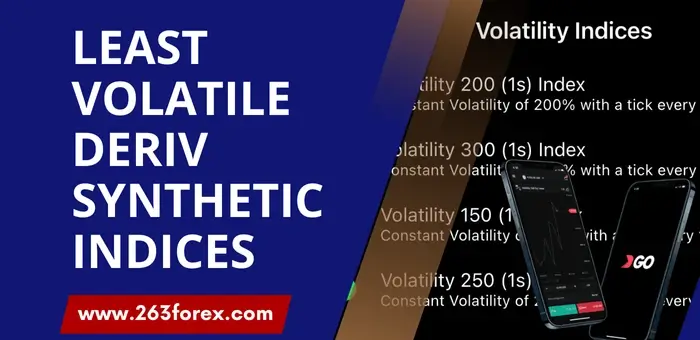Not all traders are thrill-seekers chasing rapid market movements. Some prefer the calm, steady pace of low-volatility indices. If you’re new to trading or looking for more predictable markets, Deriv offers several synthetic indices that fit the bill.
What Is Volatility in Synthetic Indices?
Volatility refers to the degree of variation in the price of a financial instrument over time. In synthetic indices, lower volatility means smaller and more predictable price movements, making them suitable for traders who prefer stability.
Not every trader wants to deal with slow moving instruments.
If you’re the opposite and prefer speed, check out:
👉 Most Volatile Synthetic Indices on Deriv →
Top 5 Least Volatile Synthetic Indices on Deriv
1. Volatility 10 Index (V10):
- Known for its minimal price fluctuations, V10 is ideal for beginners.
- Tick Frequency: Every 2 seconds.
- Minimum Lot Size: 0.3.
2. Volatility 25 Index (V25):
- Offers slightly more movement than V10 but remains relatively stable.
- Tick Frequency: Every 2 seconds.
- Minimum Lot Size: 0.5
3. Jump 10 Index:
- Features sudden jumps at predictable intervals, allowing for strategic trading.
- Minimum Lot Size: 0.01.
4. Step Index:
- Characterised by consistent, small-step movements, making it highly predictable.
- Minimum Lot Size: 0.1.
5. Multi-Step Indices:
- Recently introduced, these indices offer lower volatility and are designed for strategic flexibility.
Why Trade Low Volatility Indices?
- Suitable for beginners learning market dynamics.
- Lower risk of significant losses due to smaller price swings.
- Ideal for testing new strategies in a controlled environment.
- Suitable for trend following and longer-term strategies.
🚨 Slow Doesn’t Mean Safe: Why You Still Need to Trade Carefully
Just because an index moves slowly doesn’t mean it’s easy to trade.
In fact, some traders blow their accounts on V10 or Step Index — not because of wild spikes, but because they overtrade, use big lot sizes, or take too many positions thinking it’s “safe.”
These indices may be calm, but that also means trades take longer to play out. If your strategy isn’t tested or you’re too impatient, you’ll end up closing early or compounding losses slowly — until your account’s gone.
So what should you do?
- Test every strategy on demo before going live
- Stick to the minimum lot size until you’re consistent
- Avoid opening more than 1 or 2 positions at once
- Use stop-losses even on slow movers — they still trend, they still reverse
Take it from me: slow doesn’t mean foolproof. Treat these markets with the same respect you would V75.
🔗 Related Guides
- 📘 New to synthetic indices? Start here:
How to Trade Synthetic Indices on Deriv → - ⚡ Prefer fast-paced markets?
Most Volatile Synthetic Indices on Deriv → - 🧾 Dont have an account? Open One using the Step-By-Step instructions below
Open a Synthetic Indices account →
🧠 Conclusion
These calm markets are great for learning, testing, or just trading with less pressure. But don’t relax your discipline. Volatility might be low — but the market still punishes sloppy entries, impatience, and overtrading.
Trade smart, start small, and build up as you gain confidence. But don’t get overconfident, these markets will humble you.
— Jafa Omar
FAQ’s On Least Volatile Synthetic Indices
Volatility 10 (V10) is generally the slowest-moving synthetic index on Deriv, ideal for beginners and low-risk testing.
Not always. Slow movement doesn’t mean easier profits — it just means you need more patience and better timing.
es. If you use large lot sizes or open too many positions, you’ll still get margin calls — just not as fast.
Volatility 10 or Step Index — both move in a more stable pattern and allow time to think through your trades.
Absolutely. Even calm indices can trend against you. Use SLs and always start small.



Other Posts You May Be Interested In
Guide To Deriv Drift Switch Indices: A Trader’s Insight
📅 Last updated: May 4, 2025 ✍️ Written by: Jafar Omar ✅ Fact-checked by: Munyaradzi [...]
Exness Account Types Review 2024 🔍A Comprehensive Guide
📅 Last updated: May 8, 2025 ✍️ Written by: Jafar Omar ✅ Fact-checked by: Munyaradzi [...]
HFM Zero Spread Account Review
📅 Last updated: July 10, 2024 ✍️ Written by: Jafar Omar ✅ Fact-checked by: Munyaradzi [...]
HFM Demo Account Review 🎮Practice Your Strategies Risk-Free
📅 Last updated: July 10, 2024 ✍️ Written by: Jafar Omar ✅ Fact-checked by: Munyaradzi [...]
How To Open Deriv Demo Account MT5 (2025) ✔
📅 Last updated: May 18, 2025 ✍️ Written by: Jafar Omar ✅ Fact-checked by: Munyaradzi [...]
⚖️ Advantages and Disadvantages of Trading Synthetic Indices
📅 Last updated: May 5, 2025 ✍️ Written by: Jafar Omar ✅ Fact-checked by: Munyaradzi [...]